Forging On
The Last of the Quahog Tong Makers
By Ellen Liberman | Photographs by Jesse BurkeThe clam has but two defenses: a shell and a foot. It uses the latter to burrow as much as 11 inches under the sea floor, where it hopes to live quietly in the muck, filtering phytoplankton for a dozen or so years, on average. (Ming the mollusk is officially the longest-lived ocean quahog, reaching 506 years before being scooped up in Icelandic waters for a scientific survey.) But the clam has its enemies. They range from delicate safecrackers like moon snails, which drill a hole to suck out the toothsome meat, to smash-and-grab artists like seagulls, which drop clams on rocks to pulverize their shells.
Then there are the human predators, who have other tools at their disposal. The first clam diggers tread the shallows, feeling with their feet and harvesting by hand. But eventually, technology was brought to bear. One of the earliest implements was the hand tong for oystering, first documented in colonial Maryland in 1701. Shellfish tongs have a deceptively simple design: two sharp-toothed metal baskets are fixed to long wooden handles, called stales, and joined together, like scissors. But there’s a bushel of difference between a good set of tongs and a bad set, located someplace around the hinge point—and Harry Andersen knows exactly where it is.
On a sunny December afternoon, two pale lengths of Douglas fir lie on the bench in his Touisset workshop. Andersen favors this species for its tight, straight grain and absence of knots and pitch pockets. The flat boards are narrow at the top, where the quahogger will grasp the stales, and slightly flared at the bottom, where they will be fitted to the heads. Bill Beebe, a family friend, plants himself at the wide end, which is clamped in place and marked.
“Cut it proud to line—still have to teach these kids,” Andersen jokes.
There was a period of negotiation of how we would harvest this resource, and the hand rakers won out. Now it is all hand harvest.
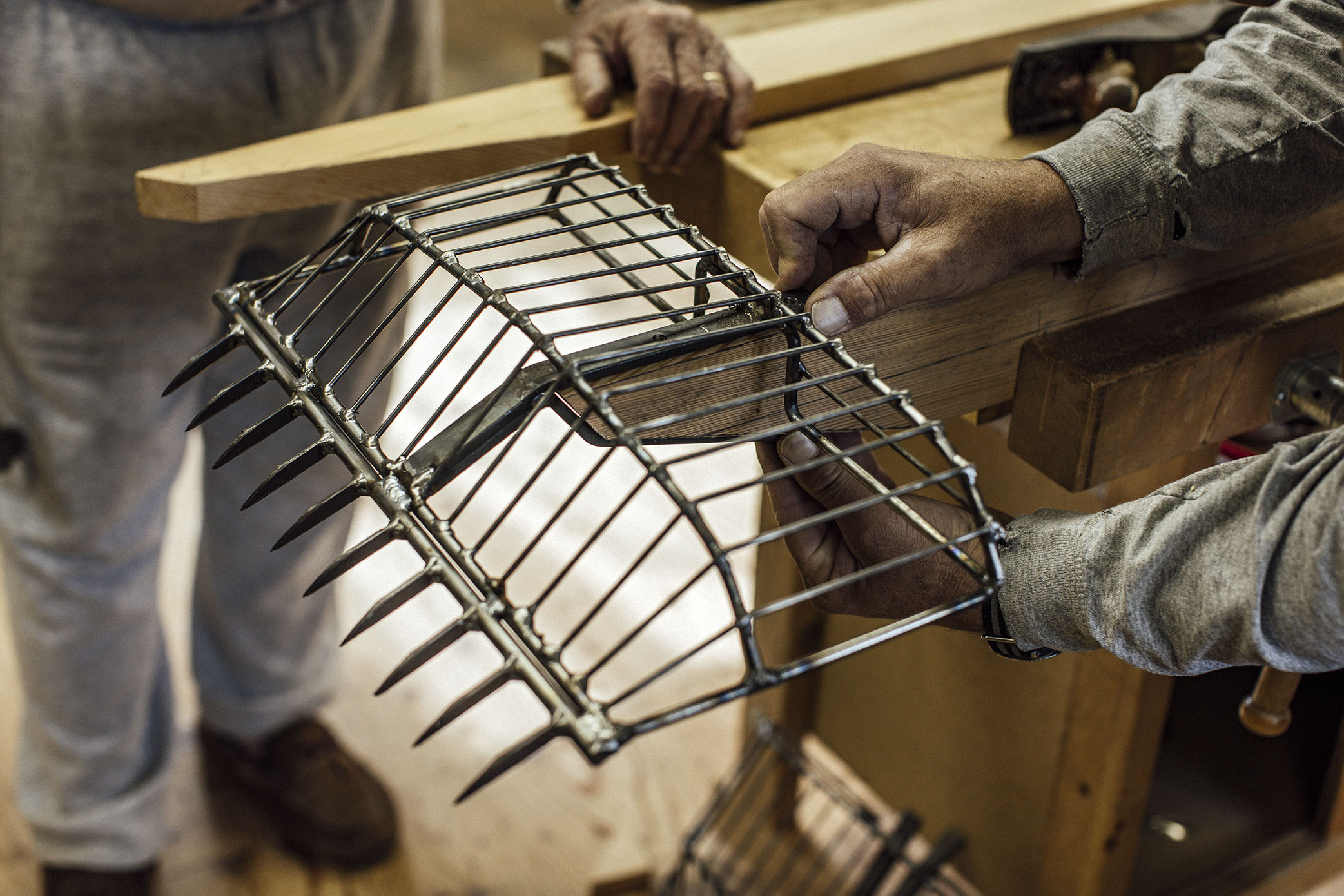
At 91, Harry Andersen has crafted wooden handles for hundreds of sets of quahog tongs.
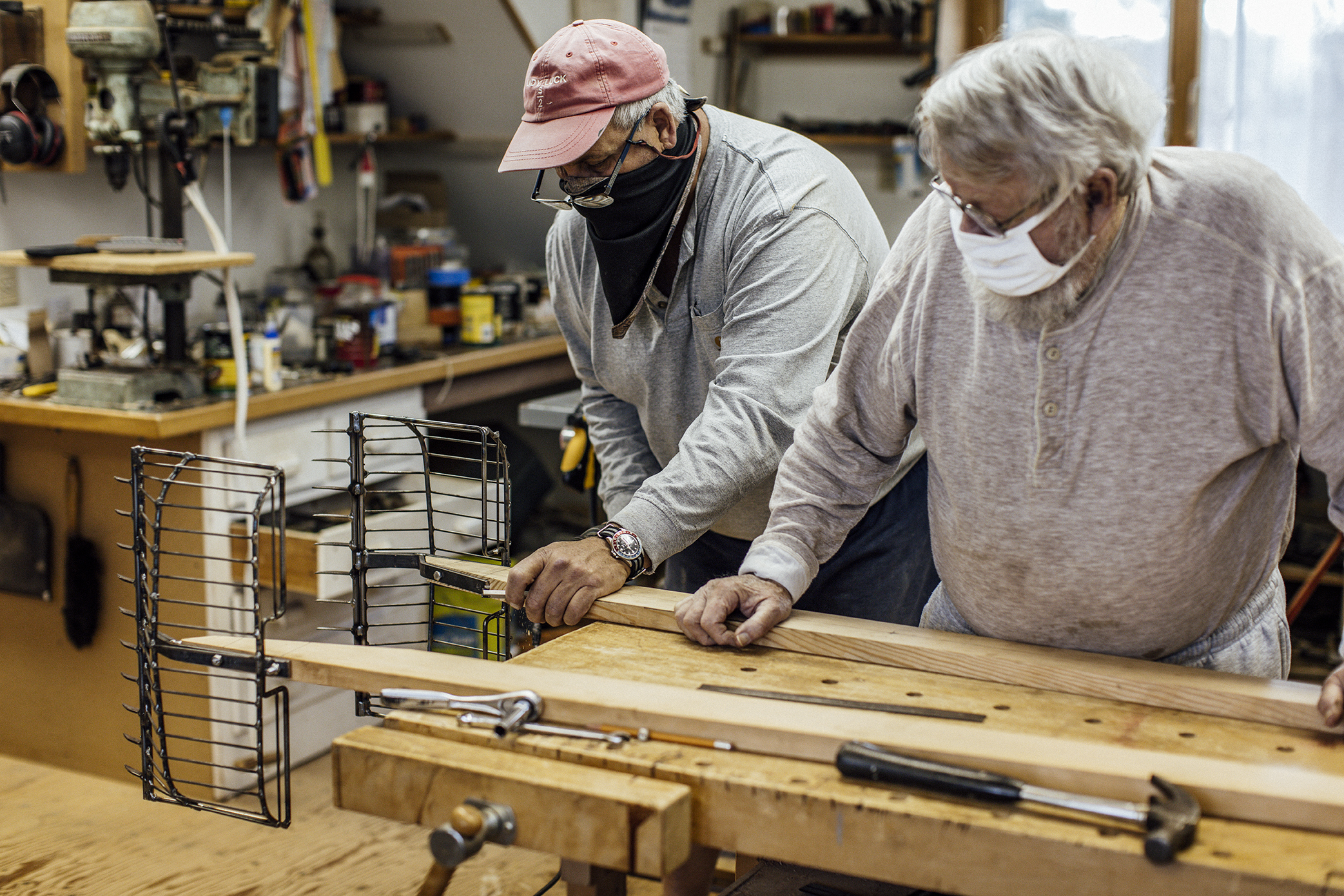
Bill Beebe and Harry Andersen hang a set of tongs for Ben Goetsch of the Rhode Island Coastal Resources Management Council.
Andersen is a baby-faced 91-year-old, with polar-night blue eyes framed by thatches of white hair on his head and chin. By his reckoning, he’s hung several hundred pairs of tongs in the last quarter century. But Andersen moves more slowly and tires more easily than when he started, so it’s Beebe who guides the skill saw along Andersen’s steeply angled pencil lines. The cut falls to the floor and the smell of sawdust rises.
Andersen’s workshop is a grand bazaar of antique hand planers and power tools, jam jars of custom washers, random boards, and intricate ropework.
“This place is a mess—a typical shop, I guess,” he says drily.
More accurately, it is a tableau of Andersen’s personal history and family heritage. His father, Anders Andersen, immigrated from Larvik, Norway, in the early 1920s. The replica of a Viking long ship mounted to the shop wall attests to his Scandinavian roots.
The family settled in Providence, where Andersen opened his carpentry business. His business sign hangs in the opposite corner, while a salesman’s sample of a curved staircase he built occupies the floor.
Harry himself started out as a journeyman carpenter, but he spent most of his career in the precision tool business, first as head of engineering for Bruce Diamond Company in Attleboro and later as head of his own company, Cone Set. He’s been on the water since he was 6 years old, sailing out of the Washington Park and Edgewood Yacht Clubs. In 1956, Andersen moved to Warren to build the house he still lives in, which hugs the banks of the Cole River.
He had a brief second career shellfishing. For two years, he was captain of the Wando River, a 92-foot ocean-going clam dredger. Then, Andersen lobstered part time for several years, aboard his own 32-foot Holland, the Edith W, named for his wife of 68 years. In 1995, he retired, and sometime around then Harry met Dennis Medeiros. Andersen’s daughter Kimberly had hired Medeiros, a clammer, a welder, and a maker of rakes and tongs, to paint her house across the street.
“We got to talking and, for some reason, he saw my shop,” recalled Andersen. “He asked me, ‘Have you ever hung clam tongs?’ I said ‘No.’ Well, I needed a pastime in retirement, and I had used clam tongs before. [Medeiros] showed me the way he did it, and I’ve done them ever since.”
Beebe cuts the second stale and switches to a hand planer to shave each end, curl by curl, to a perfect fit.
“Now the truth comes out,” Andersen says. Beebe gingerly taps one basket onto the handle, before Andersen grabs a hammer to bang it home. “Okay, let’s see how she looks.”
Beebe and Andersen stack the stales and study the marriage of metal baskets. Andersen cocks his head to take a side angle; he doesn’t like the view.
“See the teeth?” he says, “they aren’t in the middle. See the spacing? These have to be parallel.”
A Unique Pair
Tong making also requires a skilled welder to manufacture the metal baskets. Three years ago, Medeiros persuaded Ned Miller to become the heir to his tong and rake business. Miller, who studied sculpture with Connecticut artist Nicholas Swearer, had been fabricating decorative ironwork and structural steel pieces, and had never considered making shellfishing equipment.
“It kind of fell into my lap,” he recalls.
In another instance of serendipity, Medeiros was scouting Tiverton real estate when he spotted a welder’s business sign. That man wasn’t interested in buying Medeiros’ operation, but he passed on Miller’s name.
“The next thing I know, Dennis calls me about this opportunity. We met and agreed on a price, and I would work with him for couple of months to learn the nuances of building bull rakes. It’s a specialty. A lot of the parts and pieces are made off handmade jigs, and quahog fisherman are a solitary and picky crew,” he says.
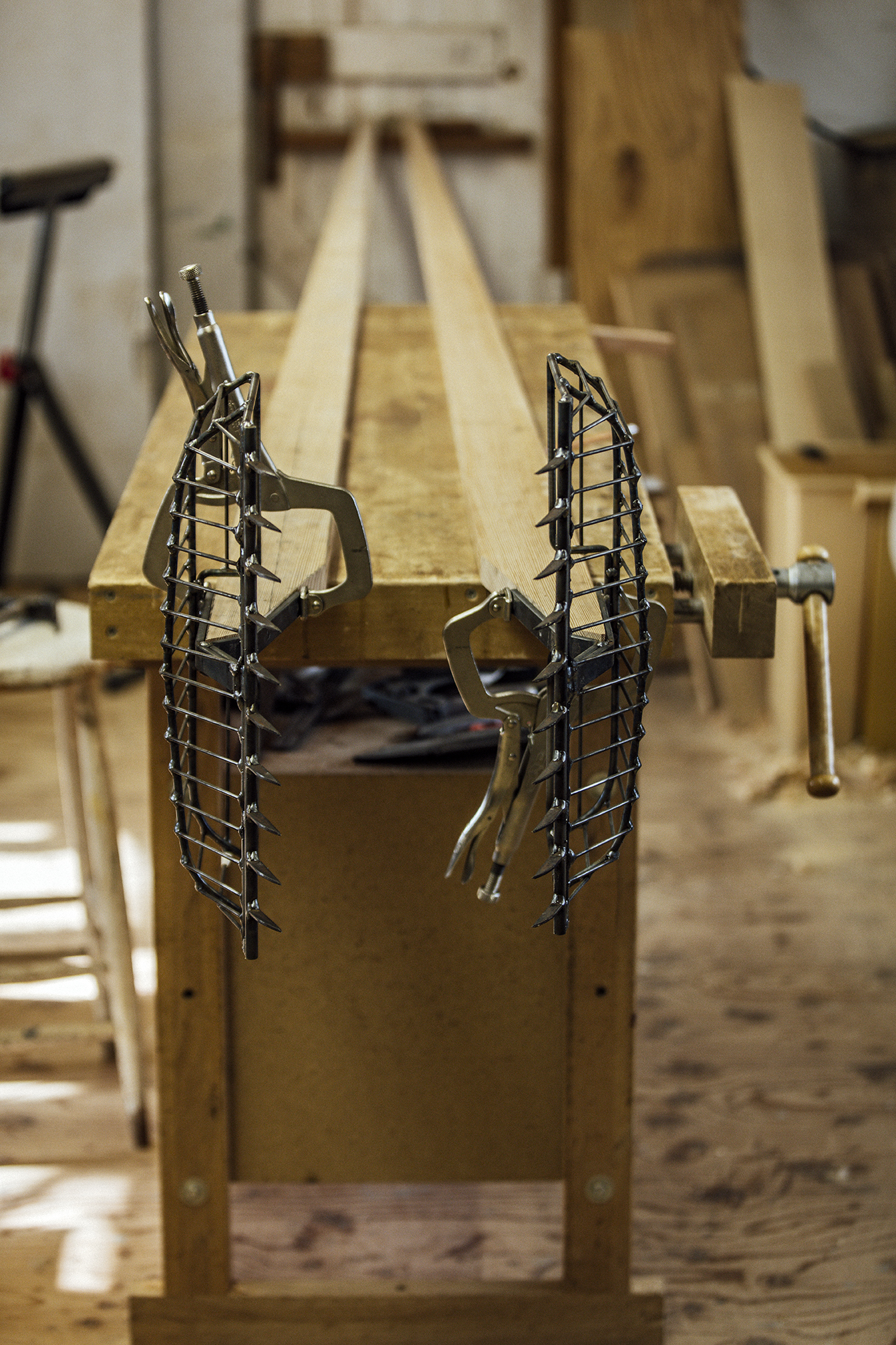
This really is a dying art form.
“I was afraid I would take over the business and they would throw up their hands after 30 years buying equipment from the same guy. Someone new changes things—even subtle changes. It’s a safe assumption that the fishermen wouldn’t be happy about that.”
By all accounts, Miller and Andersen have worked well together. But their partnership feels fragile.
Ben Goetsch, the Rhode Island Coastal Resources Management Council’s (CRMC) aquaculture coordinator, ordered the pair on Andersen’s workbench for himself, after trying to replace the tongs the department uses for shellfish sampling. His predecessor conducted surveys with his personal pair, and when he retired, he took his tongs with him. As far as Goetsch could figure, Andersen is the only one who still makes the stales and knows how to hang them properly. Miller is the last blacksmith on the East Coast—maybe the entire country—still forging heads.
“This really is a dying art form,” Goetsch says.
The Clam Tong’s Heyday
Tong making has always been the province of individual crafters, inviting few innovations. The U.S. Patent Office database, going back to 1791, contains one patented clam tong design, from 1929.
“Everyone tried their own thing and saw what was working and copied that. Even still, the rakes are made by a guy in his shed—nothing mass-produced here,” says Sarah Schumann, author of Rhode Island’s Shellfish Heritage: An Ecological History.
Nor was there much demand for clam tongs until after World War II. Oysters were the main fishery, Schumann says. For 30 glorious years, the money was in oyster farming or harvesting seed stock for the big players. By 1911, there were 21,000 acres of Narragansett Bay bottom under lease. But the industry collapsed under the combined weight of ecological and economic forces: metal effluent and raw sewage polluted the water, the Hurricane of 1938 demolished the shucking sheds, soil run-off silted the seabed, the war drained the labor pool, and the per-bushel price flatlined.

Ned Miller
As Schumann recounts, the wreckage of the oyster industry created the ideal conditions for the rise of the quahog fishery and the ranks of its wild harvesters. The hard-bottom estuary softened into a mucky habitat favored by the hard-shelled Mercenaria mercenaria, also known as the northern quahog, which is landed today. In the 1920s, state regulators began to take note of the clams’ abundance. About 20 years later, Rhode Islanders took up quahogging in earnest.
“Before it was more of a fringe activity,” Schumann says. “In the 1940s people flocked to it as an industry, and going to work on the water became more of a full-time job. That’s when they started to improve how they harvested.”
Historians have identified 15 different harvesting methods or tools, used at different times and in different regions. Clammers have used rakes, in one form or another, since at least 1863. The progenitor of the modern bullrake was purportedly invented in 1940 by Long Island shellfishermen and refined to its present design in 1974.
In the Narragansett Bay fishery, tongs dominated until then. The real tension arose between those who put their backs to the task and those who preferred the efficiency of machines. World War II launched a fleet of 40 dredge boats, plying the bay. A dredger could scoop up in minutes what cost a manual harvester hours of labor.
The battle made the newspapers and prompted the General Assembly to progressively confine the dredgers to deeper waters. Dredging was officially prohibited in 1969. But a drop in demand for the larger “chowder” clams that the dredgers harvested dismantled the fleet more decisively than legislation.
“At that time there were two cultures,” Schumann says. “One wanted to harvest with their hands using man-made rakes and tongs, but others wanted to harvest in a mechanized fashion. There was a period of negotiation of how we would harvest this resource, and the hand rakers won out. Now it is all hand harvest.”
Clam tongs, however, were on their way out as the professional’s tool of choice. Stales top out at 20 feet, limiting the tonger to depths of 14 feet or less. The resource was moving farther offshore and out of a tong’s grasp. Bullraking required more muscle and technique to work with the skiff’s drift, but it had two key advantages over tongs: you could quahog in deeper waters and catch clams in different types of sediment. In the late 1980s, divers began competing with tongers in the shallower hunting grounds.
Tongs still have their enthusiasts, even though their numbers have diminished.
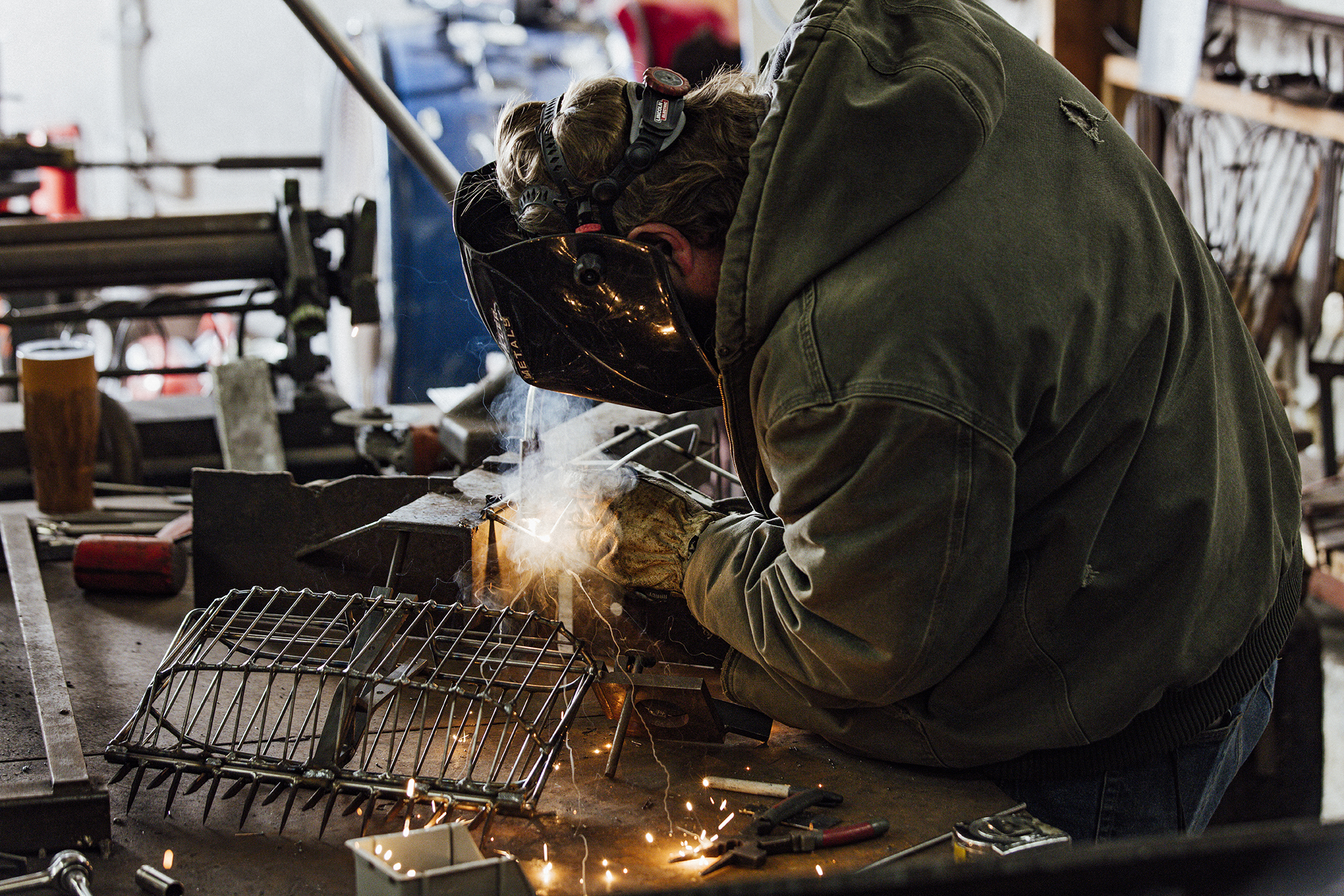
Tongs still have their enthusiasts, even though their numbers have diminished.
“If you get a guy who knows what he’s doing with a set of tongs, you’re going to get a lot of clams, if he’s got the right bottom,” says Bill Long, a retired fisherman from Wakefield who had hired Miller and Andersen to make his set of tongs. “A good tonger can do as good as a bullraker, but he’s not going to be in deep water.”
Goetsch has a slightly dreamier take. “There’s something to tonging. It’s interesting—a different type of meditation. Raking is playing the averages,” he says. “When tonging, you are really feeling the bottom and seeing where quahogs are or aren’t; there’s a different feel to it.”
A Place for Tongs
The sun is warm on the back of the neck, and the wind is out of the southwest at 12-15 miles an hour, as Dan Goulet pilots the SeaArk Commander along the coast of Tiverton. Goulet, the CRMC’s dredge coordinator, and Goetsch are heading to Seapowet Point to survey a skinny slice of the Sakonnet River estuary. In mid-December, the CRMC was scheduled to discuss a proposal for an oyster farm on a 3-acre patch, about 200 feet offshore, and Goetsch needed to take the bottom’s measure before the weather turned against him.
“You don’t want to put a shellfish farm on a productive shellfish bed—that’s off limits because it creates a de facto spawning sanctuary,” says Goetsch. “We want to make sure we are not [leasing] areas that are already important for commercial or recreational use.”
Tongs are Goetsch’s sampling instrument of choice, and a pair of 14-footers rest atop a storage locker on-deck. The goal was to pull up whatever inhabited the riverbed at five to eight different square-meter spots. The breeze had stirred some trepidation. Southwest winds create a lot of fetch—they weren’t entirely sure Goulet would be able to hold the boat still against the chop.
“You want to get an accurate, discrete sample,” Goetsch explains. Rakes work with the drift, so it’s difficult to identify with certainty what ground was covered. “With tongs you can drop them where you are.”
Buoys marked the proposed farm, just south of a rock jetty shouldering the beach. Goulet throttles down to ease up to the spot. They debate dropping anchor but fear that it wouldn’t take long before the boat would drift right out of the lease bounds. Using the engine torque against the waves seems the best bet; Goulet turns the bow into the wind, where the outgoing tide helps to hold the boat in place.
“You just might be all right,” he says.
Matt Steely is an assistant welder to Ned Miller and works on fabricating quahog tong baskets.
Goetsch positions the tongs above the water, and they slip straight down like a high diver. Goetsch leans over the portside gunwale, opens the stales wide, and feels the teeth grab the sediment. He draws the stales closed and vigorously shakes the tongs before hauling them up, hand over hand. Goulet and Goetsch slide the tongs horizontal to the rail and work their fingers through the black muck dripping from the basket. Rocks, some slippers, a sea snail—no clams. Goulet records the sample on a form in the wheelhouse.
The pair reposition the boat and tongs at scattered points to finish the survey; the haul of marine life remains meager: some slippers, one whelk, one old quahog, and lots of rocks. Goetsch couldn’t fault his equipment.
“These tongs work great,” he says, as they head back to the docks under the Sakonnet River Bridge. Goetsch demonstrates, interlacing his fingers together and snapping his palms closed. “The teeth have to catch the clam and pop it in the basket.”
“It has to do with the geometry of how they are hung,” he says. “Every head is different, and the teeth have to be aligned a certain way. The fulcrum position is very important to give the proper mechanical advantage, otherwise they are hard to operate. So, you are taking a big enough bite to cover some ground, but your arms only expand so wide, and you only have power between your shoulders. Where the fulcrum is based will determine how wide the basket will open when it’s shoulder-width apart, and a special formula determines the length where to put the pin. That’s pretty critical.”
A tonger also appreciates well-placed teeth. Gary White, a former Swansea police officer, has been shellfishing for side money since he was in high school. He purchased a quahogging boat and a bullrake, but “bullraking was not my thing. You have to have a knack for it. After about a year or two, I switched to tongs. They look like something very easy to put together, but the teeth have to be angled a certain direction and spaced exactly, because if they are too far apart you will lose the most valuable shellfish, which are the small ones.”
White now owns four pairs in 8-, 10-, 12- and 14-foot lengths that he uses in the Cole and Lee Rivers, which empty into Mount Hope Bay above the Rhode Island border.
“I was always happy with tongs. I could hear the ‘cling.’ You could tell if you were picking up rocks or quahogs. It has a different feel,” he says. But, the best thing about tonging, White says, is that they extend a shellfisherman’s career. The wooden stales have a natural buoyancy that makes them easier to haul. “You have 76-year-olds out there, and they can swing tongs better than a younger guy. Those old-timers make more money than I ever did.”
Requiem for the Tong Maker?
The obituary for the clam tong has been written in other coastal communities. The ecosystem shifts and the orders dry up. The tong maker ages, and there doesn’t seem to be anyone or any reason to carry on the tradition. Some here are preparing themselves for the end of this era in southern New England.
“It takes such an art to make a good pair of tongs. Even the type of wood you have to use has to be right. [Andersen’s] unbelievable,” White says. “It’s going to be difficult to find someone to make tongs like his once he goes out of business.”
Miller almost parted with Medeiros without learning how to make the heads. He literally was on his way out of Medeiros’ shop when he remembered, “Wait! You never taught me how to build tongs.” Miller couldn’t stay, so Medeiros taught his assistant, Matt Steely, who makes them today—even as the demand has steadily waned.
“The majority of my business is 90% bullrakes and 10% tongs,” Miller says. “That’s because there’s not that many tongers left, and a lot of the tongers who come in are close to retirement.”
Likewise, Andersen’s seen his business fall from hanging 20 tongs a year, to just a handful. Neither Miller nor Andersen is sure how long they’ll keep at it.
“Tongs are labor intensive, because they have twice as many teeth as a rake,” Miller says. “I tried to keep [the old] pricing for a year, but then I needed to adjust. It’s a tough balance. Everything goes up and the profit margin is low. I’ve been thinking about phasing them out. But there’s an historical aspect to it, and if we weren’t building them, I don’t know who would be.”
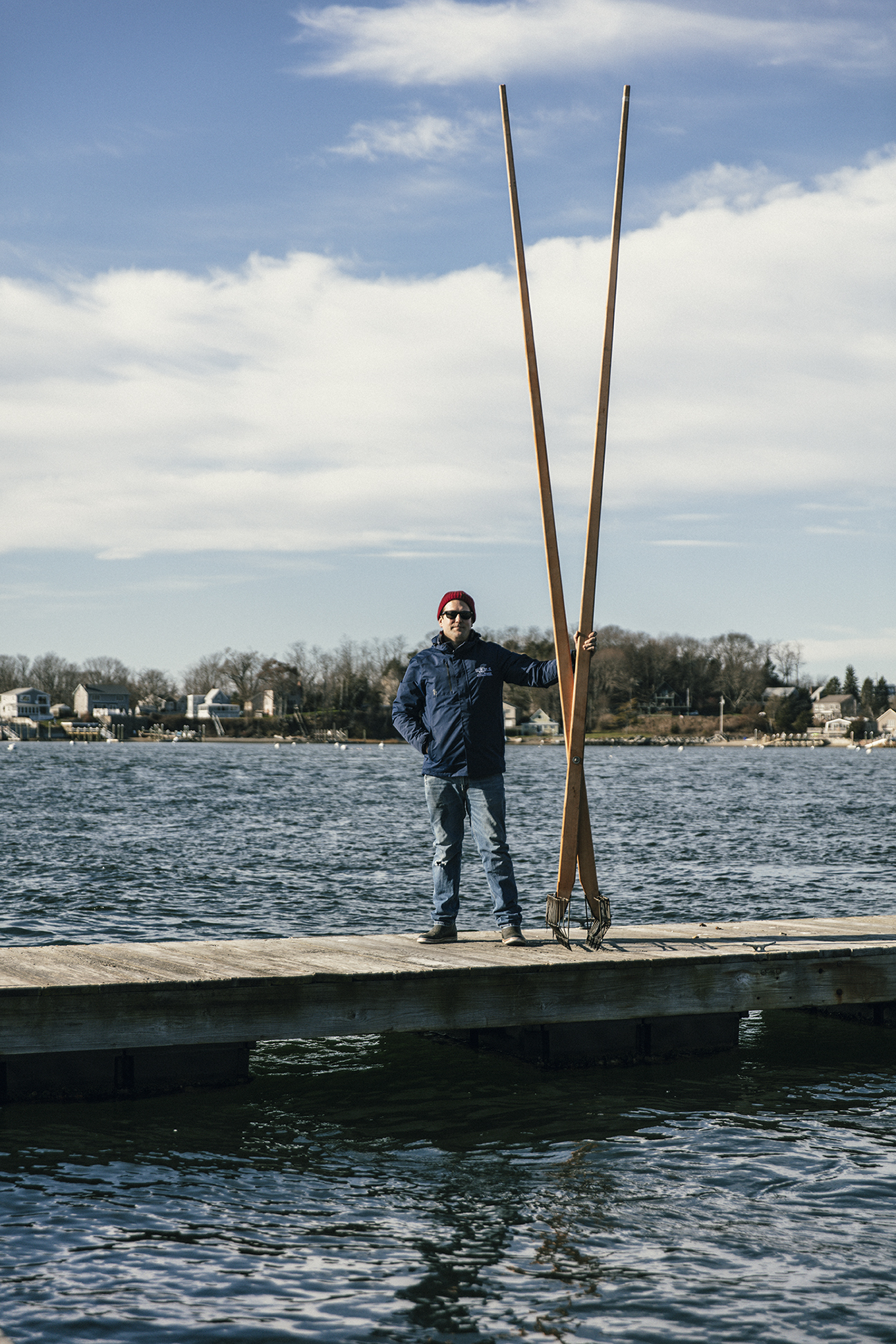
Ben Goetsch uses tongs to determine whether a potential oyster lease has quahogs, making it unsuitable for aquaculture.
Andersen is no less willing; his mind is sharp. But the old-growth fir from the West Coast was already scarce and expensive before the summer’s wildfires wiped out more of the species. Schlepping to the lumber yard, carrying the wood, and maneuvering them around his shop are tasks rapidly moving beyond his limits.
“I can’t physically do it much longer,” he says. “I’m getting too old, and it’s too hard to handle them.” He’s passing on the trade secrets to Beebe. “He’ll probably do it after I pass away—as long as somebody wants to buy them.”
Beebe and Andersen fiddle with the heads until they are satisfied that the teeth are properly nested, and then Beebe bolts them into place. He transfers the stales to the ancient Homecraft drill press that Anders Andersen once used to the drill the holes at the precise point above the baskets.
They fit a pair of washers under the bolts recessed into the wood to become the bearing point for the pin between handles. They insert the stainless bolt to join the stales together and open and close the tongs to test the hinge.
“Yeah,” Andersen says. “That should be it. Yep.”
Contact Us
Telephone: (401) 874-6805
Email: allard@uri.edu
Contributor Guidelines
Please review submission guidelines to be considered. d

